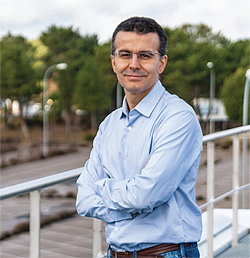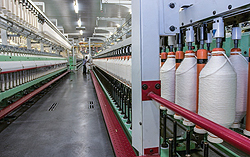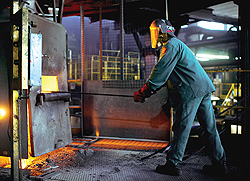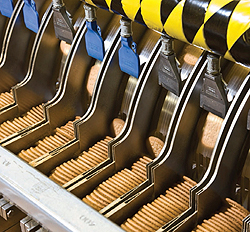 REEMAIN is an FP7 project about resource and energy efficiency solutions for factories.
REEMAIN is an FP7 project about resource and energy efficiency solutions for factories.
We have designed and tested during the last 4 years several innovative solutions in 3 different factories (cookies, textile and foundry) to prove that production can remain efficient and sustainable, while cutting energy bill and CO2 emissions. We intended to reach these goals through waste energy recovery, production optimisation and integration of renewables. Along the project, factory owners faced energy efficiency improvement in a new way. Usually, companies buy solutions. In REEMAIN we made the factories the main characters, collaborating with them, exploring the options for efficiency, helping them choosing the best solution and then making an evaluation without bias.
One example of tested technologies can be found in the biscuit factory where we took advantage of outside cool air and save an enormous amount of electricity used for water-cooling. Airside Free-cooling is a well-known technology for buildings but their usage into a factory is challenging because the temperature limits are very strict and may affect the final product. Factories use to prefer a simpler (although more inefficient) 24x7 electricity-based cooling water system rather than a more complex system capable of taking advantage of the outside renewable cool air.
The appropriate control of this energy technology is key. In the textile factory, we tested the impact of organic raw materials on the production processes and the use of carbonic acid instead of sulphuric acid for the wastewater treatment. The key here was achieving higher levels of sustainability and reduction of environmental footprint, without compromising quality and energy spent.
 One of the most challenging objective was the integration of renewables. Due to high costs, poor ROI and selfconsumption legal uncertainties, we did not integrate renewable electricity into factories. It is more a market constraint than a failure. Indeed, from the technical point of view, direct integration of small-medium shares of renewable electricity into a factory is quite simple, but lot needs to be done at political level to foster the wide adoption of renewables in the manufacturing sector.
One of the most challenging objective was the integration of renewables. Due to high costs, poor ROI and selfconsumption legal uncertainties, we did not integrate renewable electricity into factories. It is more a market constraint than a failure. Indeed, from the technical point of view, direct integration of small-medium shares of renewable electricity into a factory is quite simple, but lot needs to be done at political level to foster the wide adoption of renewables in the manufacturing sector.
Another challenge was to recover heat from the cupola furnace in the Foundry factory. The high variations of temperature and the harsh environment created by the exhaust fumes put a lot of pressure on the heat exchanger materials and on the control needed to recover as much as possible waste heat.
Current foundries need to waste a lot of energy to cool down the exhaust fumes of their furnaces. Hence, when the exchanger technology is mature it will have a huge impact on these industries.
 Among the different solutions created, we are particularly proud of the simulation tool soft are that relies on information such the technical description of the factories including the envelope and how the different machines are interconnected and create their products (cookies, metal pieces or cool denim fabric in REEMAIN). The tool also relies on data about production history and energy use. With this information, the tool analyzes the working profiles and gives the manager a preliminary advice where to save energy and resources.
Among the different solutions created, we are particularly proud of the simulation tool soft are that relies on information such the technical description of the factories including the envelope and how the different machines are interconnected and create their products (cookies, metal pieces or cool denim fabric in REEMAIN). The tool also relies on data about production history and energy use. With this information, the tool analyzes the working profiles and gives the manager a preliminary advice where to save energy and resources.
Having identified these efficiency spots and taking advantage of a digital model of the factory, one can simulate different solutions, like a PV solar roof. The simulations provide its optimal size so it covers enough electricity demand and have an appropriate ROI. In this case the tool informs about the percentage of renewable electricity coverage and when is happening according the manufacturing schedule. Therefore, the tool allows you to mix your real factory with "virtual" solutions before commit an investment.
 Apart from the technical solutions tested, we are compiling into an e-book a set of best practices that gathers interesting practical experience gained during our project. For example, the installation of efficiency measures into the factories has brought to the surface quite a large number of small faults and mismatches in existing measurement and control systems. The fact that one system provides the required energy does not mean necessarily it is performing in the most efficient way.
Apart from the technical solutions tested, we are compiling into an e-book a set of best practices that gathers interesting practical experience gained during our project. For example, the installation of efficiency measures into the factories has brought to the surface quite a large number of small faults and mismatches in existing measurement and control systems. The fact that one system provides the required energy does not mean necessarily it is performing in the most efficient way.
The final suggestion from our side to factories is that they should embrace the change when it comes to energy efficiency and rely on internal experience and energy use data. Data is highly relevant to find opportunities for improvement. As Peter Drucker said "If you can’t measure it, you can’t improve it".
Contact details:
Anibal Reñones, REEMAIN project coordinator CARTIF, Systems Division. Deputy head of Unit
Email: aniren@cartif.es
This project has received funding from the European Union's Seventh Programme for research, technological development and demonstration under grant agreement No 608977